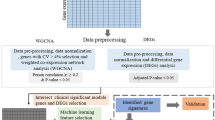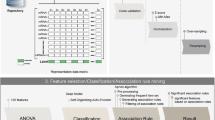Abstract
Asthma is a complex heterogeneous disorder with hereditary tendency and the most widely used therapy is inhalation of anti-inflammatory corticosteroids. But it has systemic side effects. If the chronic inflammation can be detected in early stage, the dosage of corticosteroids will be low and the side effects can be avoided. Therefore, to discover the early stage blood biomarkers for asthma, we analyzed the gene expression profiles in the blood of 77 moderate asthma patients and 87 healthy controls. With advanced feature selection methods, minimal Redundancy Maximal Relevance and Incremental Feature Selection, we identified 31 genes, such as MYD88, ZFP36, CCR3 and CYP3A5, as the optimal asthma biomarker. The sensitivity, specificity and accuracy of the 31-gene Support Vector Machine predictor evaluated with Leave-One-Out Cross Validation were 0.870, 0.816 and 0.841, respectively. Through literature survey, many biomarker genes have asthma associated functions. Our results not only provided the easy-to-apply blood gene expression biomarkers for early detection of asthma, but also an explainable qualitative model with biological significance.


Similar content being viewed by others
References
Lambrecht BN, Hammad H (2013) Asthma: the importance of dysregulated barrier immunity. Eur J Immunol 43:3125–3137
Roberts JK, Moore CD, Romero EG et al (2013) Regulation of CYP3A genes by glucocorticoids in human lung cells. F1000Res 2:173
Louis R, Lau LC, Bron AO et al (2000) The relationship between airways inflammation and asthma severity. Am J Respir Crit Care Med 161:9–16
Wenzel SE (2012) Asthma phenotypes: the evolution from clinical to molecular approaches. Nat Med 18:716–725
Hekking PP, Bel EH (2014) Developing and emerging clinical asthma phenotypes. J Allergy Clin Immunol Pract 2:671–680 (quiz 681)
Lockey RF (2014) Asthma phenotypes: an approach to the diagnosis and treatment of asthma. J Allergy Clin Immunol Pract 2:682–685
Los H, Koppelman GH, Postma DS (1999) The importance of genetic influences in asthma. Eur Respir J 14:1210–1227
Malmstrom K, Pelkonen AS, Makela MJ (2013) Remodeling, inflammation and airway responsiveness in early childhood asthma. Curr Opin Allergy Clin Immunol 13:203–210
Manuyakorn W, Howarth PH, Holgate ST (2013) Airway remodelling in asthma and novel therapy. Asian Pac J Allergy Immunol 31:3–10
Chapman DG, Irvin CG (2015) Mechanisms of airway hyper-responsiveness in asthma: the past, present and yet to come. Clin Exp Allergy 45:706–719
Lowhagen O (2015) Diagnosis of asthma—new theories. J Asthma 52:538–544
Barnes PJ (2011) Biochemical basis of asthma therapy. J Biol Chem 286:32899–32905
Zhang YH, Huang T, Chen L et al (2017) Identifying and analyzing different cancer subtypes using RNA-seq data of blood platelets. Oncotarget 8:87494–87511
Bigler J, Boedigheimer M, Schofield JPR et al (2017) A severe asthma disease signature from gene expression profiling of peripheral blood from U-BIOPRED cohorts. Am J Respir Crit Care Med 195:1311–1320
Huang T, Tu K, Shyr Y et al (2008) The prediction of interferon treatment effects based on time series microarray gene expression profiles. J Transl Med 6:44
Cai YD, Huang T, Feng KY et al (2010) A unified 35-gene signature for both subtype classification and survival prediction in diffuse large B-cell lymphomas. PLoS ONE. https://doi.org/10.1371/journal.pone.0012726
Zhang X, Chen C, Wu M et al (2012) Plasma microRNA profile as a predictor of early virological response to interferon treatment in chronic hepatitis B patients. Antivir Ther 17:1243–1253
Chen L, Li J, Zhang YH et al (2018) Identification of gene expression signatures across different types of neural stem cells with the Monte-Carlo feature selection method. J Cell Biochem 119:3394–3403
Wang D, Li J-R, Zhang Y-H et al (2018) Identification of differentially expressed genes between original breast cancer and xenograft using machine learning algorithms. Genes 9:155
Zhang PW, Chen L, Huang T et al (2015) Classifying ten types of major cancers based on reverse phase protein array profiles. PLoS ONE 10:e0123147
Zhang N, Wang M, Zhang P, Huang T (2016) Classification of cancers based on copy number variation landscapes. Biochim Biophys Acta (BBA): Gen Subj 1860:2750–2755
Li BQ, You J, Huang T, Cai YD (2014) Classification of non-small cell lung cancer based on copy number alterations. PLoS ONE 9:e88300
Tusher VG, Tibshirani R, Chu G (2001) Significance analysis of microarrays applied to the ionizing radiation response. Proc Natl Acad Sci USA 98:5116–5121
Peng H, Long F, Ding C (2005) Feature selection based on mutual information: criteria of max-dependency, max-relevance, and min-redundancy. IEEE Trans Pattern Anal Mach Intell 27:1226–1238
Zhou Y, Zhang N, Li BQ et al (2015) A method to distinguish between lysine acetylation and lysine ubiquitination with feature selection and analysis. J Biomol Struct Dyn 33:2479–2490
Zhao TH, Jiang M, Huang T et al (2013) A novel method of predicting protein disordered regions based on sequence features. BioMed Res Int 2013:414327
Niu B, Huang G, Zheng L et al (2013) Prediction of substrate-enzyme-product interaction based on molecular descriptors and physicochemical properties. BioMed Res Int 2013:674215
Liu L, Chen L, Zhang YH et al (2017) Analysis and prediction of drug-drug interaction by minimum redundancy maximum relevance and incremental feature selection. J Biomol Struct Dyn 35:312–329
Li J, Huang T (2017) Predicting and analyzing early wake-up associated gene expressions by integrating GWAS and eQTL studies. Biochim Biophys Acta (BBA): Mol Basis Dis. https://doi.org/10.1016/j.bbadis.2017.10.036
Huang T, Cai Y-D (2013) An information-theoretic machine learning approach to expression QTL analysis. PLoS ONE 8:e67899
Sun L, Yu Y, Huang T et al (2012) Associations between ionomic profile and metabolic abnormalities in human population. PLoS ONE 7:e38845
Zhang N, Huang T, Cai YD (2014) Discriminating between deleterious and neutral non-frameshifting indels based on protein interaction networks and hybrid properties. Mol Genet Genom. https://doi.org/10.1007/s00438-014-0922-5
Shu Y, Zhang N, Kong X et al (2014) Predicting A-to-I RNA editing by feature selection and random forest. PLoS ONE 9:e110607
Jiang Y, Huang T, Chen L et al (2013) Signal propagation in protein interaction network during colorectal cancer progression. BioMed Res Int 2013:287019
Huang T, Shu Y, Cai Y-D (2015) Genetic differences among ethnic groups. BMC Genom 16:1093
Chen L, Li J, Zhang YH et al (2017) Identification of gene expression signatures across different types of neural stem cells with the Monte-Carlo feature selection method. J Cell Biochem. https://doi.org/10.1002/jcb.26507
Reijmerink NE, Bottema RW, Kerkhof M et al (2010) TLR-related pathway analysis: novel gene-gene interactions in the development of asthma and atopy. Allergy 65:199–207
Shikhagaie MM, Andersson CK, Mori M et al (2014) Mapping of TLR5 and TLR7 in central and distal human airways and identification of reduced TLR expression in severe asthma. Clin Exp Allergy 44:184–196
Prabhala P, Ammit AJ (2015) Tristetraprolin and its role in regulation of airway inflammation. Mol Pharmacol 87:629–638
Shah S, Mostafa MM, McWhae A et al (2016) Negative feed-forward control of tumor necrosis factor (TNF) by tristetraprolin (ZFP36) is limited by the mitogen-activated protein kinase phosphatase, dual-specificity phosphatase 1 (DUSP1): implications for regulation by glucocorticoids. J Biol Chem 291:110–125
Neighbour H, Boulet LP, Lemiere C et al (2014) Safety and efficacy of an oral CCR3 antagonist in patients with asthma and eosinophilic bronchitis: a randomized, placebo-controlled clinical trial. Clin Exp Allergy 44:508–516
Lamkhioued B, Abdelilah SG, Hamid Q et al (2003) The CCR3 receptor is involved in eosinophil differentiation and is up-regulated by Th2 cytokines in CD34+ progenitor cells. J Immunol 170:537–547
Ying S, Robinson DS, Meng Q et al (1997) Enhanced expression of eotaxin and CCR3 mRNA and protein in atopic asthma. Association with airway hyperresponsiveness and predominant co-localization of eotaxin mRNA to bronchial epithelial and endothelial cells. Eur J Immunol 27:3507–3516
Hukkanen J, Vaisanen T, Lassila A et al (2003) Regulation of CYP3A5 by glucocorticoids and cigarette smoke in human lung-derived cells. J Pharmacol Exp Ther 304:745–752
Moore CD, Roberts JK, Orton CR et al (2013) Metabolic pathways of inhaled glucocorticoids by the CYP3A enzymes. Drug Metab Dispos 41:379–389
Cosio BG, Dacal D, Perez de Llano L (2018) Asthma-COPD overlap: identification and optimal treatment. Ther Adv Respir Dis 12:1753466618805662
Palomo J, Dietrich D, Martin P et al (2015) The interleukin (IL)-1 cytokine family–balance between agonists and antagonists in inflammatory diseases. Cytokine 76:25–37
Doz E, Noulin N, Boichot E et al (2008) Cigarette smoke-induced pulmonary inflammation is TLR4/MyD88 and IL-1R1/MyD88 signaling dependent. J Immunol 180:1169–1178
Couillin I, Vasseur V, Charron S et al (2009) IL-1R1/MyD88 signaling is critical for elastase-induced lung inflammation and emphysema. J Immunol 183:8195–8202
Givi ME, Redegeld FA, Folkerts G, Mortaz E (2012) Dendritic cells in pathogenesis of COPD. Curr Pharm Des 18:2329–2335
Di Padova F, Quesniaux VFJ, Ryffel B (2018) MyD88 as a therapeutic target for inflammatory lung diseases. Expert Opin Ther Targets 22:401–408
Barnes PJ (2003) Cytokine-directed therapies for the treatment of chronic airway diseases. Cytokine Growth Factor Rev 14:511–522
D’Ambrosio D, Mariani M, Panina-Bordignon P, Sinigaglia F (2001) Chemokines and their receptors guiding T lymphocyte recruitment in lung inflammation. Am J Respir Crit Care Med 164:1266–1275
Barnes PJ (2001) Cytokine modulators as novel therapies for airway disease. Eur Respir J Suppl 34:67s–77s
Smyth LJ, Starkey C, Gordon FS et al (2008) CD8 chemokine receptors in chronic obstructive pulmonary disease. Clin Exp Immunol 154:56–63
Kaur-Knudsen D, Bojesen SE, Nordestgaard BG (2014) CHRNA3 and CYP3A5*3 genotype, lung function and chronic obstructive pulmonary disease in the general population. Pharmacogenet Genom 24:220–229
Seo T, Pahwa P, McDuffie HH et al (2008) Association between cytochrome P450 3A5 polymorphism and the lung function in Saskatchewan grain workers. Pharmacogenet Genom 18:487–493
Anttila S, Hukkanen J, Hakkola J et al (1997) Expression and localization of CYP3A4 and CYP3A5 in human lung. Am J Respir Cell Mol Biol 16:242–249
Acknowledgements
This study is supported by The Key Science-Technology Innovation Team of Zhejiang Province (2011R50016), National Natural Science Foundation of China (31701151), Shanghai Sailing Program (16YF1413800) and The Youth Innovation Promotion Association of Chinese Academy of Sciences (2016245).
Author information
Authors and Affiliations
Corresponding authors
Ethics declarations
Conflict of interest
The authors declare that there is no conflict of interest regarding the publication of this paper.
Rights and permissions
About this article
Cite this article
Wang, SB., Huang, T. The early detection of asthma based on blood gene expression. Mol Biol Rep 46, 217–223 (2019). https://doi.org/10.1007/s11033-018-4463-6
Received:
Accepted:
Published:
Issue Date:
DOI: https://doi.org/10.1007/s11033-018-4463-6




